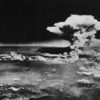
The film Oppenheimer has reignited discussion of the political and moral circumstances surrounding the U.S. atomic attack 78 years ago today on Hiroshima. Here are 10 articles CN ran on the 75th anniversary exploring the debate over the bomb.
Many people ask how can Julian Assange, an Australian who’s never operated in the U.S., be prosecuted under the U.S. Espionage Act. Here is the answer.